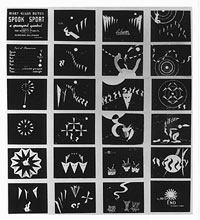Mary Ellen Bute
CVM's Bute Research Portal

Bute Retrospective Program and other film rentals
The Bute Retrospective film program presented by Center for Visual Music features 16mm prints from our Cecile Starr Collection. Several films are presented digitally. Details below.
Selected individual films can be rented on 16mm or digital files from CVM. Abstronic, Polka Graph, Color Rhapsodie, Rhythm in Light, Tarantella, Spook Sport and Parabola are available as digital files for screenings, exhibition display and classroom streaming. We are working to make others available soon. Please contact us if you'd like to help with the digitization and restoration, or make a donation with link on our home page..
For bookings, contact CVMaccess (at) gmail.com
Info on upcoming & Recent Screenings
Seeing Sound: Mary Ellen Bute Retrospective Program
Rhythm in Light, 1934, b/w, 5 min. Music: Grieg's "Anitra's Dance." Collaboration with Melville Webber and Ted Nemeth. Premiered at Radio City Music Hall, 1935. In the "Rhythm in Light," the artist uses visual materials as the musician uses sound. Mass and line an brilliant arabesques from the inexhaustible imagination of the artist perform a dance to the strains of Edward Grieg's music. The visual and aural materials are related both structurally and rhythmically - a mathematical system being used to combine the two means of expression. (promotional flyer, Ted Nemeth Studios). Review in Time Magazine, Dec. 3, 1934.
Synchromy No. 2, 1935, b/w, 5 min. Music: Wagner's "Evening Star." Premiered at Radio City Music Hall (read a Literary Digest 1936 review here). "...pretty advanced and amusing" - New York Times. NOTE: Due to print damage this title has been removed from the program.
Dada, 1936, b/w, 3 min. For Universal Newsreel. "Animated with Dada humor to a waltz tune. Witty and delightful, it flashes off the screen too soon." - CUE magazine.
Parabola, 1937, b/w. Music: Darius Milhaud's "La Creation du Monde." Based on Rutherford Boyd's extraordinary sculpture elaborating the parabolic curve. Note: Boyd has elsewhere been credited as one of the co-filmmakers; that is false. Bute and Nemeth went to court against him over inaccurate credits on this film.
Escape, 1937, color, 5 min. Music: Bach's "Toccata and Fugue in D Minor." Escape was based on a simple plot set against a musical background, and employed geometric figures for the action. (Bute)

Spook Sport (animated by Norman McLaren from concept paintings by Bute), 1939, color. Music: Saint-Saen's "Danse Macabre." A new abstract movie in the 'Seeing Sound' series by M.E. Bute. "Fun abstract movie that PEOPLE are TALKING ABOUT, filled with disembodied spooks, bats and bones." -Allene Talmey, Vogue. Note: McLaren has elsewhere been credited as the director; that is false. Bute is the Director, McLaren is the Animator. Bute storyboard mage, and film still (c) CVM
Tarantella, 1940, color, 5 min. Piano music by Edwin Gershefsky. "An exciting new technique...Unusual and amusing..." (Film Daily). Note: Elsewhere there have been erroneous credits stating Norman McLaren animated this film. That is false. Chosen for the 2010 National Film Registry, by The Library of Congress. Image (c) CVM
Polka Graph (Fun with Music), 1947, color, 5 min. Began as an actual chart of Shostakovich's Polka from "The Age of Gold." Award winner at Venice Film Festival. Screens digitally. Image (c) CVM. Available on the CVM DVD.
Color Rhapsodie, 1948, color, 6 min. Music: Liszt's "Hungarian Rhapsody No. 2." Premiered at Radio City Music Hall 1951. "[Bute] transcends her influences; her visual imagination triumphs. I like the romantic flair of COLOR RHAPSODY, its visual density...I think it is time to re-see and re-evaluate all of Bute's work in a new light." - Jonas Mekas, Soho Weekly News (9/23/76). Available on the CVM DVD.TRAILER
Pastorale, 1950, color. Music: J.S. Bach's "Sheep May Safely Graze." A pictorial accompaniment in abstract forms.
Abstronic, 1952, color, 6 min. Music: Aaron Copland's "Hoe Down" and Don Gillis's "Ranch House Party." These electronic pictures of the music are a natural phenomena which take place in the sub-atomic world; they are then captured on the Cathode Ray Oscilloscope and filmed with the motion picture camera. The colored backgrounds are hand done and superimposed on the electronic animation of the musical themes. In this movie, film artist Mary Ellen Bute combines Science an Art to create "Seeing Sound." (Press release from Ted Nemeth Studios). This title screens digitally TRAILER. Available on the CVM DVD.
Mood Contrasts, color, 1953. Music: "Hymn to the Sun" from The Golden Cockerel and "Dance of the Tumblers" from The Snow Maiden by Rimsky-Korsakov. Premiered at Radio City Music Hall. One of Bute's oscilloscope films. "An abstract film made in this fashion provides, in the making as well as the seeing and listening, one of the most thrilling experiences the motion picture affords." (Jesse Zunser, "Kinetic Space," CUE Magazine) Image (c) CVM
Imagination, c. 1958, color, 3 min. Produced for the Steve Allen show. "...surrealist film...unreal and delectable shapes floating about...the work of Mary Ellen Bute - a pioneer in this sort of thing whose talents should be more often used." - Gilbert Seldes, Saturday Review
New Sensations in Sound, c. 1959, color. Advertisement produced for RCA sales meetings. Image (c) CVM
(end Retrospective program)
For research, classroom and private home use: Three Bute films are included on CVM's new Visual Music 1947-1986 from CVM Archive DVD: Polka Graph, Color Rhapsodie and Abstronic.
Full details, ORDER INFO here Also available at CVM's regular online store. Image above from Polka Graph.
Images (c) Center for Visual Music. Please seek permission before reproducting.
Become a Member of CVM - support the expansion of these research pages
Contact us: cvmaccess at gmail dot com
Thanks to all who have donated to our Bute digitization project, named at the bottom of this page
email to join our mailing list: list (at) centerforvisualmusic (dot) org